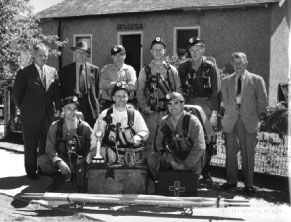
There is camaraderie among those who toil beneath the surface to eke out a living in the rocks, and the relationship became clear in the miraculous rescue of 33 miners in Chile on the 13 of October.
“I have been following closely, because when you are down there you can always imagine getting trapped,” said Bob Moffatt, who worked as a pony driver in mines in the area. “I can remember taking note of every place where there was a ladder up to a ventilation outlet or a pump. That’s what I remember being scared about the most.”
Moffatt was never in a cave-in during his career underground, but he was on shift when there was a “squeeze” that threatened to collapse a mine entry.
“You’ve heard of bumps, where the floor comes up and crashes into the roof, in a squeeze it comes up very slowly,” he said. This was often caused by natural gas pressure pushing on the layers of rock from below.
“They put about eight of us together to re-timber the whole thing to keep it from caving in. We would have lost that whole entry. We were thinking, if this fails, we’re going to be in here a long time. In those days it could be forever.”
Moffatt was there on a couple occasions when there were some narrow escapes.
“I was lucky, the roof came down a couple times, but that was where the miners were working, one guy was buried pretty badly. I dug him out, and he had a couple of broken ribs and contusions,” said Moffatt.
The valley has had its share of tragedy underground. According to the Atlas Coal Mine’s records there have been 150 fatalities. 43 per cent were from rock fall. Between 1925 and 1935 there were 33 deaths by rockfall.
Adam Horehled was a contract miner in the valley and worked for 15 years in various mines. He said there was always a possibility of something happening when he went underground.
“Mining is a dangerous business,” he said, adding part of mining was putting it out of your head.
“When you are young you could put up with that type of thing, but now it is scary business,” he said.
Ann Sarsfield was also watching what was happening in Chile with great interest. Her father was a fire boss. As stressful as it was to the miners, the families also knew of the inherent risk.
“Mind you, you got used to it, and never thought about it until you heard the ambulances, and then you wondered, ‘who is it today?’” she said.
As a fire boss, her father was in charge of explosives, at times an even more risky position.
"It wasn’t the greatest way in the world to make a living, but what else could you do?” she said.
There was one incident she recalls when there was a major explosion, and she never saw her father for a week, they didn’t know if he was dead or alive. While she was young, she saw the stress it put on her mother. The community was close knit, and news spread quickly.
“We had a local telephone office, and she was good enough to phone everybody and tell them it was not you,” said Sarsfield.
For Moffatt, he was always aware of the risks, but said you couldn’t dwell on it.
“The first week I was claustrophobic, but it was a job and there were no other jobs around,” he said. “You couldn’t work in there if you were terrified every day.”